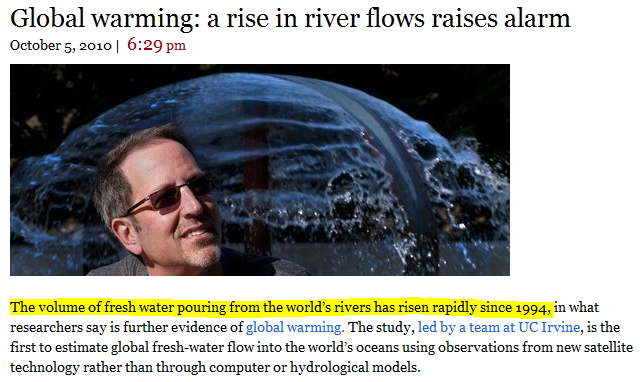Shocking! Dramatic increase in the world’s rivers
Shocking! Dramatic decrease in the world’s rivers.
WASHINGTON – The flow of water in the world’s largest rivers has declined over the past half-century, with significant changes found in about a third of the big rivers. An analysis of 925 major rivers from 1948 to 2004 showed an overall decline in total discharge.
The reduction in inflow to the Pacific Ocean alone was about equal to shutting off the Mississippi River, according to the new study appearing in the May 15 edition of the American Meteorological Society’s Journal of Climate.
The only area showing a significant increase in flow was the Arctic, where warming conditions are increasing the snow and ice melt, said researchers led by Aiguo Dai of the National Center for Atmospheric Research in Boulder, Colo.
http://english.sina.com/technology/p/2009/0422/235755.html
We have consensus. All imaginary phenomena are due to CO2.



Dear Gawd, we’re gonna die. It’s just like the warming scientists said! We’ll die of thirst while drowning. See! It’s all true!
not if you are in europe or n america. global warming will make it colder.
http://stevengoddard.wordpress.com/2010/11/06/nasa-global-warming-could-plunge-north-america-and-western-europe-into-a-deep-freeze/
according to NASA, we are going to freeze to death because of global warming
It appears California does not have a problem with the ocean rising because at the reduced rate of river flow the Pacific Ocean will dry up relatively soon.
Let’s think about how both can be right.
Over 50 years the globe has been cooling which leads to reduced river flows because of reduced precipitation.
For the Cherry picked short period of the first study the regions were warming and that lead to an increased precipitation with increased river flow.
All this is leaving out increased water usage by increased population resulting in increased evaporation on land and decreased outflow to the oceans.
All that is meaningless because it is based on insufficient data for a global weather pattern.
I suggest sending NCAR the link to the LA Times article, and UC Irving a link to the SINA article, and let them fight it out to the death. Should be entertaining.
http://www.wired.com/science/discoveries/news/2009/04/dayintech_0410 Imagine if another Tambora happened, Merapi is really getting active
Dave N says:
November 8, 2010 at 2:02 am
I suggest sending NCAR the link to the LA Times article, and UC Irving a link to the SINA article, and let them fight it out to the death. Should be entertaining.
IF ONLY!
If there is increased river flow it is probably due to increased run off. As more and more land is covered with buildings and roads there is less land available to soak up rain. So man may be responsible but it has nothing to do with the climate and nothing to do with greenhouse gases.
Notice these are the threads that no Brendon’s or ChrisD’s show up on. LOL
Ah, wait a minute! How do you measure the depth/cross-section of a river from a satellite? YOu may get the width, but the depth profile is a tad very important.
And how do you measure the rate of flow? This is beginning to smell in my opinion. (I need more details.)
Just because it is done via satellite, it does not mean that it means a thing.
I can think of a mechanism by which you can plausibly have reduced precipitation and increased runoff — think transpiration efficiency in a less CO2-starved atmosphere:
increased water-efficiency => reduced soil drying => faster soil saturation => increased precipitation runoff and you don’t even need to account for increased hard paving.
The regional confounding factors make their claims, um… flexible. Consider the amount of aquifer drawdown for agricultural irrigation – precipitation draining into aquifer recharge is not available for runoff, so you could have increased precipitation and reduced surface runoff.
In short, stream flow is too narrow a parameter and subject to too many regional influences and variations to gauge changes in precipitation or the broader hydrological cycle. The observations could be genuine as far as registering short-term regional trends are concerned but the conclusions are lazy and populist (Gasp! Global Warming!).
Thanks to Steven Goddard for juxtaposing these conflicting and frankly foolish claims.